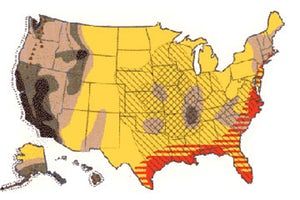Look for These 5 Geological Hazards Before Buying a Home
When you buy a home, you want to know everything about the investment you are making so you don’t get stuck with any unpleasant (and expensive) surprises.
That’s why a home inspection is completed before any contract is signed. However, the inspection shouldn’t end with just the structure. The property itself can be even more important to inspect so you can know if there are there any existing geological hazards.
Here are some hazards you should be aware of before you seriously consider purchasing a property, along with some tactics for dealing with them should any exist.
1- Seismic Activity
Earthquakes are not uncommon in California. In fact, 15-20 of them with a 4.0 or greater magnitude happen every year.
Most shakers cause minimal damage to home and property but occasionally significant damage can take occur, especially if you live in a location at risk for liquefaction (when sediment temporarily loses stability and acts as a fluid).
How to Spot It
Visible evidence that liquefaction has taken place in the past include ejected sand, cracked ground, lowered ground surface, and uprooted service tanks. Visible evidence of shaking-induced land damage includes cracking and buckling.
Check with a local planning agency for a map of active seismic areas.
How to Deal with It
If you fall in love with a house that happens to sit on liquefiable land, you do have options. Robert Snow, a Utah-based geotechnical engineer, says, “Foundational improvements can be made by a structural engineer to protect the structure. For example, parts of the foundation can be strapped together or tied down to strengthen your home during shaking. Building piers deep into more stable soil underneath the home will protect it during a liquefaction event.”
Purchasing a separate earthquake insurance policy on top of your standard homeowners insurance policy is a must.
2- Likelihood of Landslide
Problem areas include structures that are built on or near old or existing landslides, on top of or at the base of slopes, and in or at the base of minor drainage hollows.
How to Spot It
Features that might be noticed before a major landslide include unusual bulges in the ground or pavement, water seeping through the ground, soil moving away from foundations, leaning trees and telephone poles, and offset fence lines.
How to Deal with It
Engineering a solution to mitigate a potential landslide problem may be the only option for property owners of at-risk sites. Wolfgang Roth, a geotechnical engineer in California says that potential landslide problems can be mitigated with such solutions as:
Fixing sprinklers
Clearing blocked drainage ditches
Covering the ground with deep-rooted plants
Installing wire netting or ground spikes
Drilling drain pipes
Building a slide or retaining wall
3- Wildfire Threats
A large, destructive, and dangerous fire that spreads quickly can take place any time lightning strikes or humans create a spark.
How to Spot It
Take the Homeowner Wildfire Assessment and check out your local Fire Hazard Severity Zone Map to find out if the property you are purchasing is at risk.
How to Deal with It
Be sure the home is up to date on all fire codes. Make sure the property is located in an area that has two ways out (so you won’t be blocked in), is near fire hydrants, and offers ease of access for fire vehicles.
Obtain adequate homeowners insurance that extends from the outside structure of your home to all of the contents inside of it.
4- Feasibility of Flooding
Flooding can be a devastating consequence of severe rainfall, strong winds, stream runoff, dam breakage, and tsunami.
How to Spot It
Low-lying areas that have a higher likelihood of flooding such as on a coast, near a riverbend, or downstream from a dam.
How to Deal with It
In some areas, retaining walls can be built and vegetation can be planted to help break the power of moving water and reduce erosion. Also, check that all waterways and culverts are not blocked by litter and debris.
Usually, a separate flood insurance policy is a good idea, especially for homes built on a floodplain.
5- High Wind Warnings
Severe winds can cause tree branches to drop, structures to collapse, and power lines to fall.
How to Spot It
High winds can occur in any location, especially before, during, or after a severe storm. Canyon areas tend to feel stronger gusts of wind due to their “funneling” effect.
How to Deal with It
Certain home shapes and roof types can better resist high winds. They include low-rise structures, elevated structures on an open foundation, and roofs with multiple slopes and without overhangs. Also, cut away any trees or branches that are susceptible to damaging the home.
A typical homeowners insurance policy should cover damage due to high winds.
It is so important to do your due diligence well before you set your heart on a specific location. Knowing beforehand the home’s geological hazards and what engineering mitigation options exist will cost a little up front but may save you significantly (both financially and emotionally) in the future.
For information about home insurance and the variety of coverage options for your home, contact Insurance Center Associates today!















